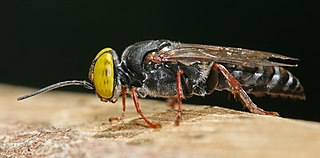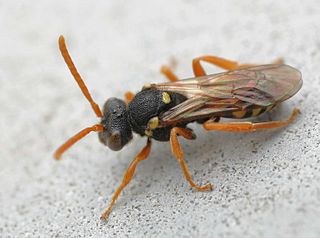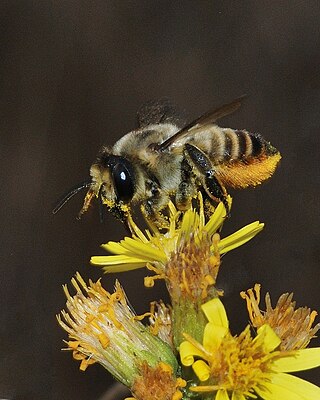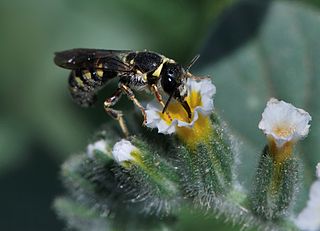
Apidae is the largest family within the superfamily Apoidea, containing at least 5700 species of bees. The family includes some of the most commonly seen bees, including bumblebees and honey bees, but also includes stingless bees, carpenter bees, orchid bees, cuckoo bees, and a number of other less widely known groups. Many are valuable pollinators in natural habitats and for agricultural crops.

Megachilidae is a cosmopolitan family of mostly solitary bees. Characteristic traits of this family are the restriction of their pollen-carrying structure to the ventral surface of the abdomen, and their typically elongated labrum. Megachilid genera are most commonly known as mason bees and leafcutter bees, reflecting the materials from which they build their nest cells ; a few collect plant or animal hairs and fibers, and are called carder bees, while others use plant resins in nest construction and are correspondingly called resin bees. All species feed on nectar and pollen, but a few are kleptoparasites, feeding on pollen collected by other megachilid bees. Parasitic species do not possess scopae. The motion of Megachilidae in the reproductive structures of flowers is energetic and swimming-like; this agitation releases large amounts of pollen.

Halictidae is the second-largest family of bees with nearly 4,500 species. They are commonly called sweat bees, as they are often attracted to perspiration. Halictid species are an extremely diverse group that can vary greatly in appearance. These bees occur all over the world and are found on every continent except Antarctica. Usually dark-colored and often metallic, halictids are found in various sizes, colors and patterns. Several species are all or partly green and a few are red, purple, or blue. A number of them have yellow markings, especially the males, which commonly have yellow faces, a pattern widespread among the various families of bees. The family is one of many with short tongues and is best distinguished by the arcuate basal vein found on the wing. Females in this family tend to be larger than the males.

The Crabronidae are a large paraphyletic group of wasps, including nearly all of the species formerly comprising the now-defunct superfamily Sphecoidea. It collectively includes well over 200 genera, containing well over 9000 species. Crabronids were originally a part of the Sphecidae, but the latter name is now restricted to a separate family based on what was once the subfamily Sphecinae. Several of the subfamilies of the Crabronidae are often treated as families in their own right, as is true of the most recent phylogenies.

Mason bee is a name now commonly used for species of bees in the genus Osmia, of the family Megachilidae. Mason bees are named for their habit of using mud or other "masonry" products in constructing their nests, which are made in naturally occurring gaps such as between cracks in stones or other small dark cavities. When available, some species preferentially use hollow stems or holes in wood made by wood-boring insects.

The term cuckoo bee is used for a variety of different bee lineages which have evolved the kleptoparasitic behaviour of laying their eggs in the nests of other bees, reminiscent of the behavior of cuckoo birds. The name is perhaps best applied to the apid subfamily Nomadinae, but is commonly used in Europe to mean bumblebees Bombus subgenus Psithyrus. Females of cuckoo bees are easy to recognize in almost all cases, as they lack pollen-collecting structures and do not construct their own nests. They often have reduced body hair, abnormally thick and/or heavily sculptured exoskeleton, and saber-like mandibles, although this is not universally true; other less visible changes are also common.

The Colletidae are a family of bees, and are often referred to collectively as plasterer bees or polyester bees, due to the method of smoothing the walls of their nest cells with secretions applied with their mouthparts; these secretions dry into a cellophane-like lining. The five subfamilies, 54 genera, and over 2000 species are all evidently solitary, though many nest in aggregations. Two of the subfamilies, Euryglossinae and Hylaeinae, lack the external pollen-carrying apparatus that otherwise characterizes most bees, and instead carry the pollen in their crops. These groups, and most genera in this family, have liquid or semiliquid pollen masses on which the larvae develop.

Nomadinae is a subfamily of bees in the family Apidae. They are known commonly as cuckoo bees.

The Apinae are the subfamily that includes the majority of bees in the family Apidae. It includes the familiar "corbiculate" bees—bumblebees, honey bees, orchid bees, stingless bees, Africanized bees, and the extinct genus Euglossopteryx. It also includes all but two of the groups that were previously classified in the family Anthophoridae.

The genus Megachile is a cosmopolitan group of solitary bees, often called leafcutter bees or leafcutting bees; it also includes the called resin bees and mortar bees. While other genera within the family Megachilidae may chew leaves or petals into fragments to build their nests, certain species within Megachile neatly cut pieces of leaves or petals, hence their common name. This is one of the largest genera of bees, with more than 1500 species in over 50 subgenera. The alfalfa leafcutter bee is managed on a commercial scale for crop pollination, and has been introduced by humans to various regions around the world.

Trochilinae is one of the six subfamilies that make up the hummingbird family Trochilidae.

The bee subfamily Panurginae is a diverse lineage of 33 genera in 7 tribes. They are particularly diverse in the New World, though scarce in the tropics, and in the Old World they can be found primarily in the Palaearctic and Africa, but absent from Australia and tropical Asia. They tend to be associated with xeric or sandy habitats.

Anthidium manicatum, commonly called the European wool carder bee, is a species of bee in the family Megachilidae, the leaf-cutter bees or mason bees.

Anthidium maculosum is a species of bee in the family Megachilidae, the leaf-cutter, carder, or mason bees. It is a solitary bee where the males are territorial and the females take part in polyandry. The males of A. maculosum differ from most other males of bee species because the males are significantly larger than females. In addition, subordinate males that act as satellites are smaller than territory-owning males. This species can be found predominately in Mexico and the United States.
Osmia avosetta is a species of mason bee. It is solitary by nature, and is notable for its distinctive use of flower petals to construct nests for its larvae.

Anthidiini is a tribe of insects in the family Megachilidae. There are at least 40 genera and 840 described species in Anthidiini. There is strong evidence that the tribe is monophyletic.

Osmiini is a tribe of leafcutter, mason, and resin bees in the family Megachilidae. There are about 19 genera and at least 1,000 described species in Osmiini.

Hoplitis is a genus of bees in the family Megachilidae. There are more than 380 described species in Hoplitis.

Lithurginae is a subfamily of woodborer bees in the family Megachilidae.

Ochreriades is a genus within Megachilidae. This taxon has been considered the sister lineage "to a clade consisting of the “core” Osmiini, the tribe Megachilini and the genera Pseudoheriades and Afroheriades."


















